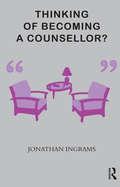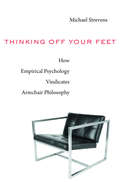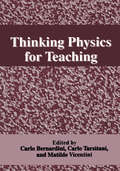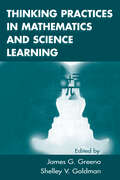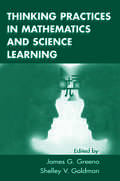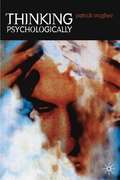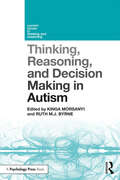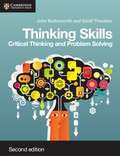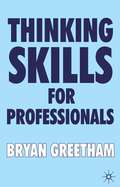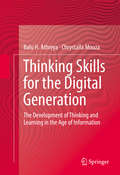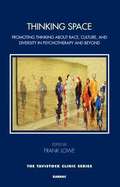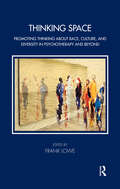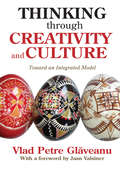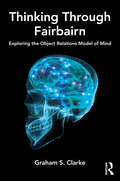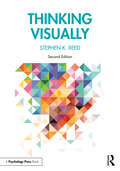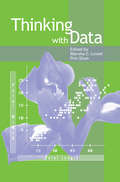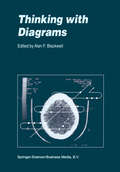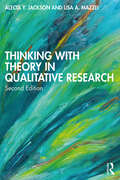- Table View
- List View
Thinking of Becoming a Counsellor?
by Jonathan IngramsIf you are thinking of becoming a counsellor, you may be wondering if you could put to good use your own life experience by offering support and understanding to those trying to cope with difficulties that you may have encountered and worked through yourself. The ancient Greek aphorism "know thyself" is immensely important in this regard. For unless counsellors are in harmony with themselves they cannot truly relate to the needs of those they seek to help. It is not enough for the counsellor to play the role of the therapist. He or she has to be the therapist - a very different concept. This book explores the journeys of self-discovery that prompted the pioneering practitioners to direct their skills in particular ways and the influence exerted by their backgrounds, ambitions, and personal histories. The overall objective is to help intending therapists to arrive at an understanding of the inner resources they will need to embark on a counselling career, and to help them determine which approach might best accord with their temperament and lifetime's experience.
Thinking Off Your Feet: How Empirical Psychology Vindicates Armchair Philosophy
by Michael StrevensIn an original defense of armchair philosophy, Michael Strevens seeks to restore philosophy to its traditional position as an essential part of the quest for knowledge, by reshaping debates about the nature of philosophical thinking. His approach explores experimental philosophy’s methodological implications and the cognitive science of concepts.
Thinking Physics for Teaching
by C. Bernardini C. Tarsitani M. VicentiniThe research in Physics Education has to do with the search of solutions to the complex problem of how to improve the learning and teaching of physics. The complexity of the problem lies in the different fields of knowledge that need to be considered in the research. In fact, besides the disciplinary knowledge in physics (which must be considered from the conceptual, the historical, and the epistemological framework), one has to take into account some basic knowledge in the context of psychology and the cognitive sciences (for the general and contextual aspects of learning) and some basic knowledge in education and comunication (for what concerns teaching skills and strategies). Looking back at the historical development of the research one may recognize that the complexity of the endeavour was not clear at first but became clear in its development, which shifted the focus of the research in the course of time from physics to learning to teaching. We may say that the research started, more than 30 years ago, with a focus on disciplinary knowledge. Physicists in different parts of the western world, after research work in some field of physics, decided to concentrate on the didactical comunication of physical knowledge.
Thinking Practices in Mathematics and Science Learning
by James G. Greeno Shelley V. GoldmanThe term used in the title of this volume--thinking practices--evokes questions that the authors of the chapters within it begin to answer: What are thinking practices? What would schools and other learning settings look like if they were organized for the learning of thinking practices? Are thinking practices general, or do they differ by disciplines? If there are differences, what implications do those differences have for how we organize teaching and learning? How do perspectives on learning, cognition, and culture affect the kinds of learning experiences children and adults have? This volume describes advances that have been made toward answering these questions. These advances involve several agendas, including increasing interdisciplinary communication and collaboration; reconciling research on cognition with research on teaching, learning, and school culture; and strengthening the connections between research and school practice. The term thinking practices is symbolic of a combination of theoretical perspectives that have contributed to the volume editors' understanding of how people learn, how they organize their thinking inside and across disciplines, and how school learning might be better organized. By touring through some of the perspectives on thinking and learning that have evolved into school learning designs, Greeno and Goldman begin to establish a frame for what they are calling thinking practices. This volume is a significant contribution to a topic that they believe will continue to emerge as a coherent body of scientific and educational research and practice.
Thinking Practices in Mathematics and Science Learning
by James G. Greeno Shelley V. GoldmanThe term used in the title of this volume--thinking practices--evokes questions that the authors of the chapters within it begin to answer: What are thinking practices? What would schools and other learning settings look like if they were organized for the learning of thinking practices? Are thinking practices general, or do they differ by disciplines? If there are differences, what implications do those differences have for how we organize teaching and learning? How do perspectives on learning, cognition, and culture affect the kinds of learning experiences children and adults have? This volume describes advances that have been made toward answering these questions. These advances involve several agendas, including increasing interdisciplinary communication and collaboration; reconciling research on cognition with research on teaching, learning, and school culture; and strengthening the connections between research and school practice. The term thinking practices is symbolic of a combination of theoretical perspectives that have contributed to the volume editors' understanding of how people learn, how they organize their thinking inside and across disciplines, and how school learning might be better organized. By touring through some of the perspectives on thinking and learning that have evolved into school learning designs, Greeno and Goldman begin to establish a frame for what they are calling thinking practices. This volume is a significant contribution to a topic that they believe will continue to emerge as a coherent body of scientific and educational research and practice.
Thinking Psychologically (PDF)
by Patrick McgheePsychology is not simply a body of fixed knowledge like some dead language, which we define, frame, package and pass on. Psychology is a living, evolving process of understanding which depends upon constant debate and discussion being actively entered into by researchers, teachers, practitioners and, yes, students, too. In order to learn about psychology we need to understand it, and in order to understand it we must actively engage with it. This book aims to help students to think psychologically; to encourage them to think more creatively, analytically and critically about almost every type of theory, book or article they will come across in their course; to show them how to be an active learner; to help them understand and question the assumptions psychologists make about the world and the kind of knowledge we can have about it.
Thinking, Reasoning, and Decision Making in Autism (Current Issues in Thinking and Reasoning)
by Kinga Morsanyi Ruth ByrneThinking and Reasoning in Autism provides fresh insights into the cognitive processes that underlie some of the typical characteristics of autism. Autism has long been considered an enigma, and no single theory so far has been able to explain, or even fully describe, the key characteristics of the autistic mind. From the interdisciplinary perspective of new research in cognitive psychology, linguistics, philosophy, and neuroscience, this book explores thinking, reasoning and decision making in autism. The new cognitive approaches challenge some of the existing assumptions of the nature of thought in autism, including presumed areas of impairments. Instead, this book focuses on the nuanced array of cognitive signatures that characterize the autistic mind, and in many cases it reveals the possibility of intact performance alongside instances of remarkably enhanced thinking. The book considers the implications of these characteristics, providing in-depth analyses of specific areas of cognitive functioning, and their everyday manifestations. Featuring contributions from world-leading researchers from the fields of cognitive science and autism research, this volume will be essential reading for advanced students and researchers, as well as those working with individuals with autism spectrum disorders.
Thinking, Reasoning, and Decision Making in Autism (Current Issues in Thinking and Reasoning)
by Kinga Morsanyi Ruth ByrneThinking and Reasoning in Autism provides fresh insights into the cognitive processes that underlie some of the typical characteristics of autism. Autism has long been considered an enigma, and no single theory so far has been able to explain, or even fully describe, the key characteristics of the autistic mind. From the interdisciplinary perspective of new research in cognitive psychology, linguistics, philosophy, and neuroscience, this book explores thinking, reasoning and decision making in autism. The new cognitive approaches challenge some of the existing assumptions of the nature of thought in autism, including presumed areas of impairments. Instead, this book focuses on the nuanced array of cognitive signatures that characterize the autistic mind, and in many cases it reveals the possibility of intact performance alongside instances of remarkably enhanced thinking. The book considers the implications of these characteristics, providing in-depth analyses of specific areas of cognitive functioning, and their everyday manifestations. Featuring contributions from world-leading researchers from the fields of cognitive science and autism research, this volume will be essential reading for advanced students and researchers, as well as those working with individuals with autism spectrum disorders.
Thinking Skills: Critical Thinking And Problem Solving (PDF)
by John Butterworth Geoff ThwaitesThinking Skills, Second edition, is the only endorsed coursebook that provides complete coverage of the Cambridge AS and A Level Thinking Skills syllabus offering substantially updated, new and revised content. It also contains extensive extra material to cover related awards. Written by experienced and highly respected authors, this book includes features such as clearly focused and differentiated units, stimulating student activities with commentaries to develop analytical skills, summaries of key concepts to review learning, end-of-chapter assignments to reinforce knowledge and skills, and a mapping grid to demonstrate the applicability of each unit to awards including Critical Thinking, BMAT and TSA.
Thinking Skills for Professionals
by B. GreethamThis book gives professionals and business people the essential tools to become better thinkers and decision-makers. It sets out simple methods and techniques to avoid poor decision making by developing our conceptual, creative and critical thinking skills, along with ways of incorporating them within our daily lives.
Thinking Skills for the Digital Generation: The Development of Thinking and Learning in the Age of Information
by Balu H. Athreya Chrystalla MouzaThis important text synthesizes the state of knowledge related to thinking and technology and provides strategies for helping young people cultivate thinking skills required to navigate the new digital landscape. The rise of technology has resulted in new ways of searching and communicating information among youth, often creating information “overload”. We do not know how the new technologies will affect the ways young people learn and think. There are plenty of warnings about the dangers of information technology, but there is also enormous potential for technology to aid human thinking, which this book explores from an open-minded perspective.Coverage Includes:- An up to date review of the literature on thinking skills in general, and in relation to technology.- Practical guidelines for thinking with technology.- A scholarly review of the characteristics of the digital generation.- A discussion of the various steps involved in the thinking process.- A historical context of the Information Age and the transition from oral history, to printing press, to the Internet.Thinking Skills for the Digital Generation: The Development of Thinking and Learning in the Age of Information is an invaluable reference for educators and research professionals particularly interested in educational technology, and improving thinking and problem-solving skills.
Thinking Space: Promoting Thinking About Race, Culture And Diversity In Psychotherapy And Beyond (PDF)
by Frank LöweThinking Space was set up to develop the capacity of staff and trainees at the Tavistock Clinic to think about racism and other forms of hatred toward difference in ourselves and others. Drawing on Bion's (1962) distinction between "knowing" and "knowing about", the latter of which can be a defense against knowing a subject in a deeper and emotionally real way, Thinking Space sought to promote curiosity, exploration and learning about difference, by paying as much attention as to how we learn (process) as to what we learn (content). This book is a celebration of ten years of Thinking Space at the Tavistock Clinic and a way of sharing the thinking, experience and learning gained over these years. Thinking Space functions, among other things, as a test-bed for ideas and many of the papers included here began as presentations, and were encouraged and developed by the experience. These papers do not seek to provide a coherent theory or set of views. On the contrary they are very diverse and decidedly so, as finding, expressing and developing one's own personal idiom involves emotional truthfulness and is an important part of getting to know oneself: both of which are important prerequisites to getting to know the other.
Thinking Space: Promoting Thinking About Race, Culture and Diversity in Psychotherapy and Beyond (Tavistock Clinic Series)
by Frank LoweThis book promotes curiosity, exploration and learning about difference by paying as much attention as to how we learn (process) as to what we learn (content). It shares the thinking, experience and learning of staff at the Tavistock Clinic, the premier psychotherapy training institution in the NHS.
Thinking Space: Promoting Thinking About Race, Culture and Diversity in Psychotherapy and Beyond (Tavistock Clinic Series)
by Frank LoweThis book promotes curiosity, exploration and learning about difference by paying as much attention as to how we learn (process) as to what we learn (content). It shares the thinking, experience and learning of staff at the Tavistock Clinic, the premier psychotherapy training institution in the NHS.
Thinking Through Creativity and Culture: Toward an Integrated Model
by Vlad Petre GlaveanuCreativity and culture are inherently linked. Society and culture are part and parcel of creativity's process, outcome, and subjective experience. Equally, creativity does not reside in the individual independent of culture and society.Vlad Petre Glveanu's basic framework includes creators and community, from which new artifacts emerge and existing artifacts are developed. He points to a relationship between self and other, new and old, specific for every creative act. Using this multifaceted system requires that researchers employ ecological research in order to capture the heterogeneity and social dimensions of creativity.Glveanu uses an approach based on cultural psychology to present creativity in lay terms and within everyday settings. He concludes with a unitary cultural framework of creativity interrelating actors, audiences, actions, artifacts, and affordances.
Thinking Through Creativity and Culture: Toward an Integrated Model (History And Theory Of Psychology Ser.)
by Vlad Petre GlaveanuCreativity and culture are inherently linked. Society and culture are part and parcel of creativity's process, outcome, and subjective experience. Equally, creativity does not reside in the individual independent of culture and society.Vlad Petre Glveanu's basic framework includes creators and community, from which new artifacts emerge and existing artifacts are developed. He points to a relationship between self and other, new and old, specific for every creative act. Using this multifaceted system requires that researchers employ ecological research in order to capture the heterogeneity and social dimensions of creativity.Glveanu uses an approach based on cultural psychology to present creativity in lay terms and within everyday settings. He concludes with a unitary cultural framework of creativity interrelating actors, audiences, actions, artifacts, and affordances.
Thinking Through Fairbairn: Exploring the Object Relations Model of Mind
by Graham S. ClarkeThinking through Fairbairn offers parallel perspectives on Fairbairn's work. It explores an extended interpretation of his 'psychology of dynamic structure' and applies that model to a number of different areas. Fairbairn's Scottish origins are explored through his relationship with the work of Ian Suttie and Edward Glover. A new extended object relations model of phantasy and inner reality that reflects Fairbairn's approach as represented by his contribution to the Controversial Discussions is also developed. In cooperation with Paul Finnegan, this version of Fairbairn's model is applied to an understanding of multiple personality disorder or dissociative identity disorder. This model is combined with Fairbairn's theory of art to provide an understanding of some 'puzzle' films based in trauma and dissociation. Fairbairn's theory is presented here as a synthesis of classical and relational approaches, and his appropriation by relational theorists as a precursor to exclusively relational approaches challenged.
Thinking Through Fairbairn: Exploring the Object Relations Model of Mind
by Graham S. ClarkeThinking through Fairbairn offers parallel perspectives on Fairbairn's work. It explores an extended interpretation of his 'psychology of dynamic structure' and applies that model to a number of different areas. Fairbairn's Scottish origins are explored through his relationship with the work of Ian Suttie and Edward Glover. A new extended object relations model of phantasy and inner reality that reflects Fairbairn's approach as represented by his contribution to the Controversial Discussions is also developed. In cooperation with Paul Finnegan, this version of Fairbairn's model is applied to an understanding of multiple personality disorder or dissociative identity disorder. This model is combined with Fairbairn's theory of art to provide an understanding of some 'puzzle' films based in trauma and dissociation. Fairbairn's theory is presented here as a synthesis of classical and relational approaches, and his appropriation by relational theorists as a precursor to exclusively relational approaches challenged.
Thinking Visually
by Stephen K. ReedThinking Visually documents the many ways pictures, visual images, and spatial metaphors influence our thinking. The book discusses recent empirical, theoretical, and applied contributions that support the view that visual thinking occurs not only where we expect to find it, but also where we do not. Much of comprehending language, for instance, depends on visual simulations of words or on spatial metaphors that provide a foundation for conceptual understanding. This edition has been fully updated throughout and features new coverage of a range of topical and fascinating areas of research, including aesthetics, visual narratives, communicating health risks, dreams, clinical imagery, mathematical games, and the influence of action on perception. It also features a new chapter on Mixed Reality to showcase the many exciting developments in this area. The broad coverage, colorful figures, and research discoveries provide a solid foundation for understanding visual thinking across a wide spectrum of activities. It will be an essential read for all students and researchers interested in Visual Thinking.
Thinking Visually
by Stephen K. ReedThinking Visually documents the many ways pictures, visual images, and spatial metaphors influence our thinking. The book discusses recent empirical, theoretical, and applied contributions that support the view that visual thinking occurs not only where we expect to find it, but also where we do not. Much of comprehending language, for instance, depends on visual simulations of words or on spatial metaphors that provide a foundation for conceptual understanding. This edition has been fully updated throughout and features new coverage of a range of topical and fascinating areas of research, including aesthetics, visual narratives, communicating health risks, dreams, clinical imagery, mathematical games, and the influence of action on perception. It also features a new chapter on Mixed Reality to showcase the many exciting developments in this area. The broad coverage, colorful figures, and research discoveries provide a solid foundation for understanding visual thinking across a wide spectrum of activities. It will be an essential read for all students and researchers interested in Visual Thinking.
Thinking With Data
by Marsha C. Lovett Priti ShahThe chapters in Thinking With Data are based on presentations given at the 33rd Carnegie Symposium on Cognition. The Symposium was motivated by the confluence of three emerging trends: (1) the increasing need for people to think effectively with data at work, at school, and in everyday life, (2) the expanding technologies available to support peopl
Thinking With Data (Carnegie Mellon Symposia On Cognition Ser.)
by Marsha C. Lovett Priti ShahThe chapters in Thinking With Data are based on presentations given at the 33rd Carnegie Symposium on Cognition. The Symposium was motivated by the confluence of three emerging trends: (1) the increasing need for people to think effectively with data at work, at school, and in everyday life, (2) the expanding technologies available to support peopl
Thinking with Diagrams
by Alan F. BlackwellThis book provides an introductory overview of the rapid growth in interdisciplinary research into Thinking with Diagrams. Diagrammatic representations are becoming more common in everyday human experience, yet they offer unique challenges to cognitive science research. Neither linguistic nor perceptual theories are sufficient to completely explain their advantages and applications. These research challenges may be part of the reason why so many diagrams are badly designed or badly used. This is ironic when the user interfaces of computer software and the worldwide web are becoming so completely dominated by graphical and diagrammatic representations. This book includes chapters commissioned from leading researchers in the major disciplines involved in diagrams research. They review the philosophical status of diagrams, the cognitive processes involved in their application, and a range of specialist fields in which diagrams are central, including education, architectural design and visual programming languages. The result is immediately relevant to researchers in cognitive science and artificial intelligence, as well as in applied technology areas such as human-computer interaction and information design.
Thinking with Theory in Qualitative Research
by Alecia Y. Jackson Lisa A. MazzeiThinking with Theory in Qualitative Research: Second Edition demonstrates how to enact various philosophical concepts in practices of inquiry, effectively opening up the process of thought in qualitative studies. Thinking with Theory in Qualitative Research functions as a refusal of pregiven method, intensifying creativity, experimentation, and newness. Readers are invited into the threshold of theory to traverse philosophers and their concepts, reorienting conventional approaches to inquiry. Each chapter presents a thinking with process as a way of reading intensively through plugging in performative accounts of two first-generation academic women to philosophical concepts from Derrida, Spivak, Foucault, Butler, Barad, and Deleuze and Guattari. This book is a deliberate attempt to unsettle what is expected to be represented or recognized in terms of both meaning and method in traditional practices of qualitative research, which become unproductive and untenable in this different image of thought. New to this edition Fully revised and rewritten Chapter 1 that introduces the technique of plugging in as contingent, strategic movements of thought. Also new to Chapter 1 is a shift in language away from traditional practices in qualitative research (data and analysis) to performative accounts and becoming-questions Fully revised "Thinking with intra-action" chapter, which focuses on Karen Barad’s ontoepistemological framework of agential realism, and the concepts of posthumanist performativity and entangled agencies Fully revised and rewritten Chapter 8 that presents plugging in and thinking with as ontological Further development of and new material on the "plugging in" technique Schematic cues updated and extended for all of the Interludes In the ten years since the first edition was published, Thinking with Theory in Qualitative Research has become a vanguard text in the field of postfoundational inquiry for its accessible but thorough introductions to philosophically informed inquiry. This book is for experienced and novice researchers, and students in introductory, general, and advanced qualitative inquiry courses, who may also be first-time readers of philosophy. This text will function as an entry into techniques of thinking with a new theoretical vocabulary.
Thinking with Theory in Qualitative Research
by Alecia Y. Jackson Lisa A. MazzeiThinking with Theory in Qualitative Research: Second Edition demonstrates how to enact various philosophical concepts in practices of inquiry, effectively opening up the process of thought in qualitative studies. Thinking with Theory in Qualitative Research functions as a refusal of pregiven method, intensifying creativity, experimentation, and newness. Readers are invited into the threshold of theory to traverse philosophers and their concepts, reorienting conventional approaches to inquiry. Each chapter presents a thinking with process as a way of reading intensively through plugging in performative accounts of two first-generation academic women to philosophical concepts from Derrida, Spivak, Foucault, Butler, Barad, and Deleuze and Guattari. This book is a deliberate attempt to unsettle what is expected to be represented or recognized in terms of both meaning and method in traditional practices of qualitative research, which become unproductive and untenable in this different image of thought. New to this edition Fully revised and rewritten Chapter 1 that introduces the technique of plugging in as contingent, strategic movements of thought. Also new to Chapter 1 is a shift in language away from traditional practices in qualitative research (data and analysis) to performative accounts and becoming-questions Fully revised "Thinking with intra-action" chapter, which focuses on Karen Barad’s ontoepistemological framework of agential realism, and the concepts of posthumanist performativity and entangled agencies Fully revised and rewritten Chapter 8 that presents plugging in and thinking with as ontological Further development of and new material on the "plugging in" technique Schematic cues updated and extended for all of the Interludes In the ten years since the first edition was published, Thinking with Theory in Qualitative Research has become a vanguard text in the field of postfoundational inquiry for its accessible but thorough introductions to philosophically informed inquiry. This book is for experienced and novice researchers, and students in introductory, general, and advanced qualitative inquiry courses, who may also be first-time readers of philosophy. This text will function as an entry into techniques of thinking with a new theoretical vocabulary.
